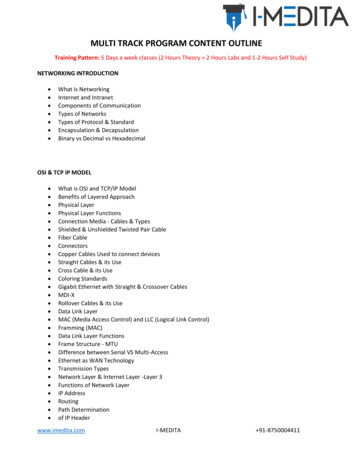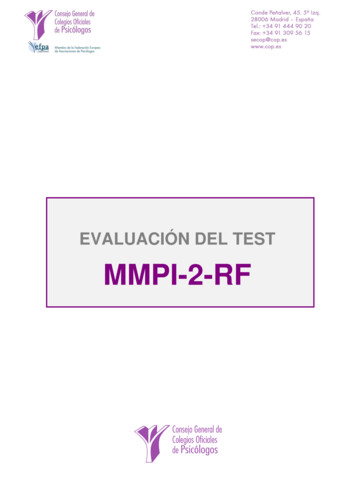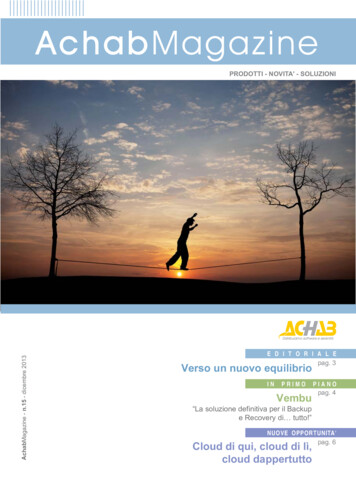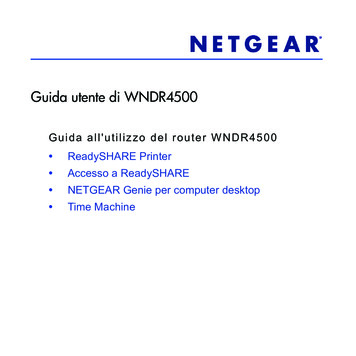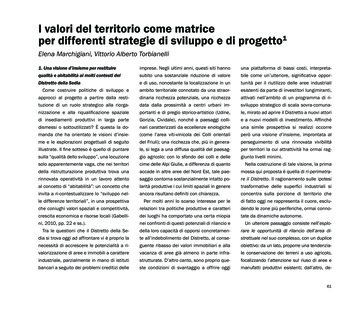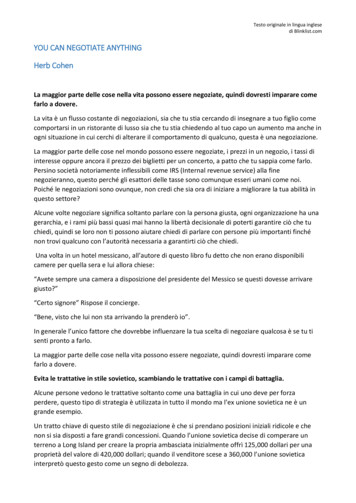
Transcription
Scientific Journal of InformaticsVol. 6, No. 2, Nov 2019p-ISSN sjie-ISSN 2460-0040Analysis Security of SIA Based DSS05 on COBIT 5Using Capability Maturity Model Integration (CMMI)Rusydi Umar1, Imam Riadi2, Eko Handoyo31Department of Informatics, Universitas Ahmad Dahlan, Indonesia,Department of Information System, Universitas Ahmad Dahlan, Indonesia,3Department of Cmputer Engineering, Universitas Muhammadiyah Lamongan, Indonesia,Email: 1rusydi umar@rocketmail.com, 2 imam.riadi@mti.uad.ac.id, 3ekokurro17@gmail.com2AbstractA secure academic information system is part of the college. The security of academicinformation systems is very important to maintain information optimally and safely. Alongwith the development of technology, academic information systems are often misused bysome irresponsible parties that can cause threats. To prevent these things from happening, itis necessary to know the extent to which the security of the academic information system ofuniversities is conducted by evaluating. So the research was conducted to determine theMaturity Level on the governance of the security of University Ahmad Dahlan academicinformation system by using the COBIT 5 framework on the DSS05 domain. The DSS05domain on COBIT 5 is a good framework to be used in implementing and evaluating relatedto the security of academic information systems. Whereas to find out the achievement ofevaluation of academic information system security level, CMMI method is needed. Thecombination of the COBIT 5 framework on the DSS05 domain using the CMMI method inacademic information system security is able to provide a level of achievement in the formof a Maturity Level value. The results of the COBIT 5 framework analysis of the DSS05domain use the CMMI method to get a Maturity level of 4,458 so that it determines theachievement of the evaluation of academic information systems at the tertiary level isManaged and Measurable. This level, universities are increasingly open to technologicaldevelopments. Universities have applied the quantification concept in each process, and arealways monitored and controlled for performance in the security of academic informationsystems.Keywords: CMMI, COBIT 5, Security SIA, Managed and Measurable,Maturity Level,1.INTRODUCTIONCompanies or institutions place information technology as a thing that cansupport the achievement of the company's strategic plan to achieve the goals of thecompany or institution's vision, mission and goals. Information technology will geteffective results if it uses good governance in its use and is able to be evaluated andevaluated[1]. Information systems are systems that contain SPD networks (systemsprocessing data), which are equipped with communication channels used in dataorganization systems[2]. There are various concepts of information systems,compatibility is one of the keys to the successful implementation and acceptanceof information systems[3]. Along with the development of technology, it is oftenmisused by some irresponsible parties that can cause threats[4]. Academic193
information systems must provide the security, privacy and integrity of dataprocessed, so that the performance of academic information systems is also animportant part that must be considered so that academic information systems canbe used optimally and safely[5]. The application of information security systemsaims to overcome all problems and constraints, both technically and nontechnically which can affect the performance of the system such as availability,confidentiality and integrity factors so that the level of information security can beassessed[6], as in Figure 1.AVAILABILITYINTEGRITYNFCOIDEITIALNTYFigure 1 Information security aspectsThe existence of a security problem triggers a procedure for controlling accessrights to an information system[7]. A good information system security must applythe standard Deming cycle of quality[8]. The security of academic informationsystems can be audited with various standards such as COBIT, COSO, ITIL, CMM,BS779, ISO 9000. COBIT (Control Objectives for Information and relatedTechnology) is a standard guide to information technology management practicesand a set of best practices documentation for IT governance that can help auditors,management, and users to bridge the gap between business risk, control needs, andtechnical issues[8]. All organizations can adjust COBIT 5 for their variouspurposes, and are able to evaluate the organization in achieving its intendedgoals[9]. Domain DSS (Deliver, Service and Support) is related to system deliveryand service support needed by the system, which includes service, security andcontinuity management, service support for users, and data management andoperational facilities so that it is more integrated in the domain that providesservices well[8]. DSS domains have sub-domain DSS05 wherein this sub-domainis a more intensive procedure for information security. The method that can be usedin evaluating the achievement of evaluation is CMMI. Capability Maturity ModelIntegration (CMMI) is a model approach to assess the scale of capability andmaturity of a software organization. The history of CMMI at the beginning wasknown as the Capability Maturity Model (CMM) which was built and developedby the Software Engineering Institute in Pittsburgh in 1987[10].Scientific Journal of Informatics, Vol. 6, No. 2, Nov 2019194
This study aims to conduct an evaluation related to the security management ofacademic information systems that have been implemented at Ahmad DahlanUniversity. This study aims to obtain the value of the level of information systemsecurity of an institution, so that recommendations and innovations can be madefor the security of information systems in these institutions.2. METHODSThe combination of both is expected to be able to provide good results in evaluatingthe security of academic information systems at the college. As in Figure 2.StartObservation of theSIA ProcessDSS05 MappingBased on theFrameworkCOBIT 5Preparation ofQuestionnaireswith acombination ofDSS05 andCapability LevelGap AnalysisMaturity LevelGap MaturityLevel CalculationCalculation of thecurrent SIASecurity LevelMaturity LevelCompilation of ITGovernanceRecommendationsFinishDATA COLLECTIONDATA PROCESSING AND ANALYSISRECOMMENDATION DESIGNFigure 2. Flowchart Method2.1. DSS05 Framework COBIT 5.The DSS05 sub-domain is managing security services where these sub-domainsare grouped in 7 processes. The seven processes carry out some activities orstatements of the 49 statements as follows[11]As in Figure 3.Scientific Journal of Informatics, Vol. 6, No. 2, Nov 2019195
Protectagainstmalware6 AktivitasManage networkandconnectivity security9 AktivitasManageendpointsecurity9 aktivitasMonitorthe infrastructurefor security-relatedevents5 Aktivitasmanage securityservices (DSS05)Manageuser identityandlogical access8 AktivitasManage sensitivedocuments andoutput devices5 AktivitasManagephysical accessto IT assets7 AktivitasFigure 3. DSS05 Method2.2. Capability Maturity Model Integration (CMMI)CMMI is a maturity method that can be used to improve processes within theinstitution. The purpose of using the CMMI within an institution is to improve theprocess of developing and improving the software product of the institution[12].According to[13] CMMI has Capability Level. Capability Level is a model todescribe how each core process runs within an institution. Capability Level has 6levels for each core process,as in Figure formedIncompleteFigure 5. Capability Level CMMIAccording to [13] The CMMI model places, institutions in 5 Maturity Levels orCMMI levels, as in Figure 6.Scientific Journal of Informatics, Vol. 6, No. 2, Nov 2019196
OptimizingQuantitatively ManagedDefinedManagedInitialFigure 6. Maturity Level CMMI3.RESULT AND DISCUSSIONAnalysis of the implementation and measurement of the maturity level of theinformation system with the framework COBIT 5 sub-domain DSS05 andCMMI.3.1 Observation of the Academic Information System ProcessThis process conducts interviews directly with the resource person who hasauthority in the security of the academic information system at BISOM.As time goes on the use of information systems also experiences, obstacles,problems and threats to information systems. The problems, obstacles and threatsthat often occur are as follows:1) There are several systems that have not been well integrated.2) When the online KRS happened the server was down.3) It often happens to forget your username and password.4) The process of data connection or transmission is slow.5) Virus and malware attacks.The selection of respondent samples using purposive sampling technique, which isthe selection of respondents 'samples determined by researchers on the grounds thatidentification of respondents' samples is done by referring to personalcompetencies that interact directly with IT governance[14]. Interviews get 2respondents who are directly concerned with the field of information systemsecurity within the institution.3.2 DSS05 Mapping Based on the COBIT Framework 5This process is a compilation of DSS05 domain conformity activities withquestions to be made in the questionnaire. because of the limitations of our writing,we only list one of the 7 DSS05 sub-domain processes, namely DSS05.01. TheDSS05.01 process consists of 6 activities, as in Table 1.Scientific Journal of Informatics, Vol. 6, No. 2, Nov 2019197
Table 1 Protect against malware activityNo12Protect against malware (DSS05.01)Activity QuestionsObtain information about malicious software and how to handle it.Install and activate anti-virus on your PC.3Is anti virus on the PC always updated.4Regularly review and evaluate information about potential malware threats.5Filter incoming traffic, such as e-mail and downloads, to protect against unsolicitedinformation.Conduct periodic training on malware in the use of e-mail and the Internet.63.3 Preparation of Questionnaires with a combination of DSS05 andCapability LevelThis process is carried out by questionnaires based on the standard onDSS05 Framework COBIT 5 by combining. To simplify the reading process, thecolor differences for each decision are made in Capability Level and MaturityLevel as in Table 2.Table 2 Process Color Maturity LevelNon-Existent InitialInitial / Ad HocRepeatable But InvinitveDefine ProcessManaged and MeasurableOptimizedCapability ly ManagedOptimizingWhere in this questionnaire there are 6 assessments for processes with capabilitylevel CMMI as in Table 3.Table 3 Assessment of IT processes with CMMI capability levelNilai012345Capability Level y ManagedOptimizingProses TIAre not doneDone, not periodicallyPerformed periodicallyDone with SOPPerformed and monitoredDone, monitored and developed3.4 Calculation of Security SIA Maturity LevelThis section will explain the results of the analysis of the implementation andmeasurement of the performance of the maturity level of academic informationsystems obtained from the results of questionnaires and interviews in accordancewith the framework 5 COBIT domain DSS05. as described in Table 4.Table 4. Value of maturity level criteriaCriteria0 – 0.500.51 – 1.501.51 – 2.502.51 – 3.503.51 – 4.504.51 – 5.00InformationNon-Existent InitialInitial / Ad HocRepeatable But InvinitveDefine ProcessManaged and MeasurableOptimizedScientific Journal of Informatics, Vol. 6, No. 2, Nov 2019198
Furthermore, the correlation between level values and absolute values that are doneby calculation in the form of an index uses a mathematical formula. Themathematical equation to determine the index value is as follows[15]:𝐼𝑛𝑑𝑒𝑘𝑠 𝑀𝑜𝑠𝑡 𝑄𝑢𝑒𝑠𝑡𝑖𝑜𝑛 𝐴𝑛𝑠𝑤𝑒𝑟𝑠(1) �� 𝑄𝑢𝑒𝑠𝑡𝑖𝑜𝑛𝑠After getting the index, we can get the current Maturity Level (present). This valueis the accumulated value of the process that is running on the institution. as in Table5.Table 5 Existing Maturity ValueDSS05Value of Maturity LevelExisting5,00Protect against malwareManage network and connectivity security5,00Manage endpoint security4,39Manage user identity and logical access4,88Manage physical access to IT assets4,64Manage sensitive documents and output devices3,10Monitor the infrastructure for security-related events4,203.5 Gap Maturity Level CalculationOnce the existing Maturity Level values are obtained and Maturity Therecommendation level (target) has been determined, then the gap between thecurrent condition and the target to be achieved will be analyzed and identifiedopportunities from the gap to be optimized, as in Table 6.Table 6 Value of Maturity Level gapDSS05TargetIndeks Maturity Level ExistingProtect against malware55.00Manage network and connectivity security55.00Manage endpoint security54.39Manage user identity and logical access54.88Manage physical access to IT assets54.64Manage sensitive documents and output devices53.10Monitor the infrastructure for security-relatedevents54.20Scientific Journal of Informatics, Vol. 6, No. 2, Nov 2019199
3.6 Gap Analysis Maturity LevelBased on Gap analysis obtained from the results of the target level to be achievedand the level achieved on DSS05, as in Graph 1, then here is some Gap MaturityLevel Analysis. As in Table 7.Table 7 Gap Maturity Level AnalysisDSS05Maturity LevelProtect against malwareOptimizedManage network and connectivity securityOptimizedManage endpoint securityManaged and MeasurableManage user identity and logical accessOptimizedManage physical access to IT assetsOptimizedManage sensitive documents and output devicesDefineMonitor the infrastructure for security-related eventsManaged and MeasurableThe overall value of Maturity Level on DSS05 will be calculated on average so thatit will get the level of Maturity Level in the organization or institution as in Formula(2).𝑀𝑎𝑡𝑢𝑟𝑖𝑡𝑦 𝐿𝑒𝑣𝑒𝑙 𝐷𝑆𝑆05 𝑀𝑎𝑡𝑢𝑟𝑖𝑡𝑦 𝐿𝑒𝑣𝑒𝑙(2)𝑚𝑎𝑛𝑦 ���05.01) 𝑖(𝐷𝑆𝑆05.02) 𝑖(𝐷𝑆𝑆05.03) 𝑖(𝐷𝑆𝑆05.04) 𝑖(𝐷𝑆𝑆05.05) 𝑖(𝐷𝑆𝑆05.06) 𝑖(𝐷𝑆𝑆05.07)𝑀𝐿𝐷𝑆𝑆5 𝑚𝑝5 5 4,388 4,875 4,642 3,1 4,27𝑀𝑎𝑡𝑢𝑟𝑖𝑡𝑦 𝐿𝑒𝑣𝑒𝑙 𝐷𝑆𝑆05 4,458From the calculation results obtained the value of achievement is 4,458 so that itcan be set Maturity Level of organization or institution is at the Managed andMeasurable level.𝑀𝐿𝐷𝑆𝑆05 3.7 Compilation of IT Governance RecommendationsAfter Maturity Level has been determined, the recommendation preparationprocess will be carried out. Recommendations that can be given to improve thequality of information system security in the agency:1) Protect against malware (DSS05.01) is on the Optimized level where inthis level the BISKOM has been able to perform procedures well and isable to develop malware related ones.2) Manage network and connectivity security (DSS05.02) is at the level ofOptimized wherein at this level the BISKOM has been able to carry outScientific Journal of Informatics, Vol. 6, No. 2, Nov 2019200
3)4)5)6)7)procedures well and is able to carry out developments related to securityof activities.Manage endpoint security (DSS05.03) in the Managed and Measurablelevel where in this level the BISKOM has been able to carry outprocedures well, only agencies must carry out routine evaluations, at leastonce a month on information systems that are feared to be potential newthreats.Manage user identity and logical access (DSS05.04) is on the Optimizedlevel where in this level the BISKOM has been able to carry outprocedures properly and is able to develop related access rights of eachuser.Manage physical access to IT assets (DSS05.05) is on the Optimized levelwhere in this level the BISKOM has been able to perform procedures welland is able to carry out development related to physical security.Manage sensitive documents and output devices (DSS05.06) in the DefineProcess level, in this BISKOM has implemented physical security,accounting practices in terms of documents relating to the situation.Monitor the infrastructure for security-related events (DSS05.07) is in theManaged and Measurable level where in this level the BISKOM of hasbeen able to carry out procedures properly using intrusion detection tools,to monitor infrastructure.4. CONCLUSIONSub-domain DSS05 Manage security services is a good procedure to be used in theimplementation and mega-audit related to the security of academic informationsystems and CMMI is a good assessment method in an institution's audit system.Based on the research conducted at the BISKOM received a Maturity Level of4,458 thus stipulating that the current maturity level is on the Managed andMeasurable level.5. REFERENCES[1]R. Umar, I. Riadi, and E. Handoyo, “Analisis Tata Kelola TeknologiInformasi Menggunakan Framework COBIT 5 Pada Domain Delivery,Service, And Support (DSS),” in Seminar Nasional Teknologi Informasidan Komunikasi - SEMANTIKOM 2017, 2017, pp. 41–48.[2]L. F. Fathoni et al., “Application Information System Based HealthServices Android,” J. Ilmu Tek. Elektro Komput. dan Inform., vol. 2, no.1, pp. 39–48, 2016.[3]I. Muslimin, S. P. Hadi, and E. Nugroho, “An Evaluation Model UsingPerceived User Technology Organization Fit Variable for Evaluating theSuccess of Information Systems,” vol. 4, no. 2, pp. 86–94, 2017.[4]Y. W, I. Riadi, and A. Yudhana, “Analisis Keamanan WebserverMenggunakan Metode Penetrasi Testing,” in Annual Research Seminar,2016, vol. 2, no. 1, pp. 300–304.[5]E. Kurniawan and I. Riadi, “Security level analysis of academicinformation systems based on standard ISO 27002:2003 using SSE-Scientific Journal of Informatics, Vol. 6, No. 2, Nov 2019201
[6][7][8][9][10][11][12][13][14][15]CMM,” Int. J. Comput. Sci. Inf. Secur., vol. 16, no. 1, pp. 139–147, 2018.Rosmiati, I. Riadi, and Y. Prayudi, “A Maturity Level Framework forMeasurement of Information Security Performance Imam Riadi,” Int. J.Comput. Appl., vol. 141, no. 8, pp. 975–8887, 2016.N. Hermaduanti and I. Riadi, “Automation framework for rogue accesspoint mitigation in ieee 802.1X-based WLAN,” J. Theor. Appl. Inf.Technol., vol. 93, no. 2, pp. 287–296, 2016.E. Hicham, B. Boulafdour, M. Makoudi, and B. Regragui, “Informationsecurity, 4TH wave,” J. Theor. Appl. Inf. Technol., vol. 43, no. 1, pp. 1–7,2012.F. Latifi and H. Zarrabi, “A COBIT5 Framework for IoT RiskManagement,” Int. J. Comput. Appl., vol. 170, no. 8, pp. 40–43, 2017.V. Konttinen, Towards Disciplined Software Development, no. May.2016.J. F. Andry, “Audit of IT Governance Based on COBIT 5 Assessments: ACase Study,” J. Teknol. dan Sist. Inf., vol. 2, no. 2, p. 27, 2016.P. D. Syafitri, “Penilaian Kualitas Pengembangan Sistem Informasi PadaPerusahaan Distributor,” J. Sist. Inf. Bisnis, vol. 10, no. 01, pp. 15–27,2016.CMMI Product Team, CMMI for Development, Version 1.3. 2010.P. Rahayu and D. I. Sensuse, “Penilaian Implementasi e-Government diPUSTEKOM Kemendikbud berbasis metode PEGI,” J. Sist. Inf. Bisnis,vol. 02, pp. 139–145, 2017.A. Prasetyo and N. Mariana, “Analisis Tata Kelola Teknologi Informasi (It Governance ) pada Bidang Akademik dengan Cobit FrameWork StudiKasus pada Universitas Stikubank Semarang,” J. Teknol. Inf. Din., vol.16, no. 2, pp. 139–149, 2011.Scientific Journal of Informatics, Vol. 6, No. 2, Nov 2019202
2.2. Capability Maturity Model Integration (CMMI) 5 CMMI is a maturity method that can be used to improve processes within the institution. The purpose of using the CMMI within an institution is to improve the process of developing and improving the software product of the institution[12]. According to[13] CMMI has Capability Level.

